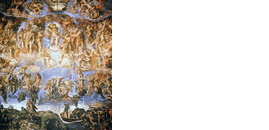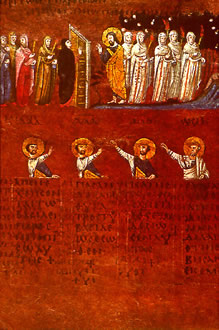
|
|
|
|
|
Class
Prep
|
|
|
|
- Utopia
in the End-Times: The Early Christian Sect
-

- Like their Essene counterparts, the early Christian sect within Judaism believed that they were living close to the end-times. They diverged from the Essenes in their belief that the end-time had already begun, ushered in by the advent of the Messiah. The texts we will read today expose some of the ways this belief was expressed in early Christian communities. (The image to the left dates from the sixth century CE, and illustrates the apocalyptic parable of the wise and foolish bridesmaids. Underneath are 3 Psalms with David sitting atop each and a passage from Hosea the prophet topped by the prophet himself; all these figures point to the gospel story their works were thought to point to.)
-
- The readings are arranged roughly in chronological order (though
2 Corinthians was written after 1 Corinthians). As you read, consider
the following issues and questions:
-
-
- 1-2 Thessalonians: How have these Christians or Paul adapted the teaching of the Messiah to the experience of Jesus' life and death? What "signs of the end" are they experiencing, and how are they reacting? What will "the end" look like -- what is the "script"?
- 2 Corinthians 12:2-4: What experience does Paul claim, and what impact does this claim have on his letter(s)? What relationship does this claim have to 1 Enoch, Daniel or the Qumran Essene community? The Collins chapter will be helpful in assessing Paul's apocalyptic perspective.
- 1 Corinthians 7:29-31: How are the Corinthians supposed to act given the knowledge that "the time has grown short"? Compare/contrast this teaching to Paul's advice in Thessalonians.
- Gospel of Mark: What evidence of apocalyptic method and features do you find in this gospel? Which of these, according to Collins, likely date to the historical Jesus, and which are likely creations of the post-resurrection church?
- Acts 2; 4:1-5:11: In Luke's portrait of the early Christian community in Jerusalem, what actions are suggested to be ongoing/regular? Speculate about why only the community in Jerusalem is described in this way.
- Didache 16: Compare this passage to the earlier Mark 13. What elements of the script remain? What elements have changed?
- The Shepherd of Hermas: What are the apocalyptic
features of the piece? So much of the work deals
with repentance and morality that some have argued it is not
an apocalypse at all. Compare the material on these
themes to today's other early Christian apocalyptic texts.
- Sibylline Oracles 2:34-55, 149-347: Are any new features
or interpretations added in this last apocalyptic work?
- According to Gager, what is a millenarian movement and is
early Christianity an example of one? What is cognitive dissonance, and how does Gager apply it to early Christianity?
-
-
- Assigned Readings
- Primary: 1–2 Thessalonians; 2 Corinthians 12:2-4; 1 Corinthians
7:29-31; Mark 1:1–3:6; 8:1–9:29; 11:1–16:8; Acts 2; 4:1–5:11
(all NRSV); Didache 16; the Shepherd of Hermas and Sibylline Oracles 2:34-55, 149-347 (Reddish 255-65, 334-42; ERes)
- Secondary: Collins 256-68; Gager, "The End of Time
and the Rise of Community" (ERes)
-
-
- Further Reading
-
- See also the section of the Course Bibliography on Jewish
and Christian Apocalypticism, 300 B.C.E.-100 C.E.
-
-
- Links
-
-
-
- Sources
- Photograph: Mario Rotili, Il Codice Purpureo di Rossano
(Sorrento, Napoli: Di Mauro, 1980) plate 4, folio 2v (cf. Matt
25:1-13 + Ps 45:15; 45:14; 53:6; Hos 7:13).
|
|
|
|
|
